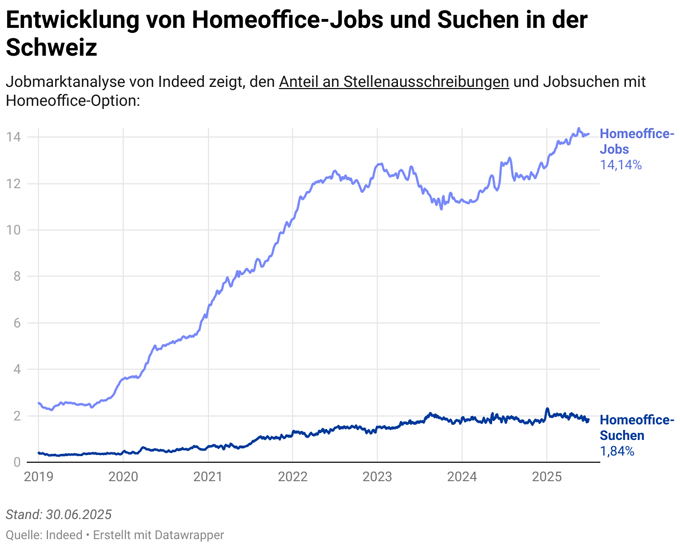App controls availability during vacations
Hybrid working has created new, digital communication channels, but has also increased constant availability. Almost a third of employees in Switzerland state that they often work in their free time. Companies are faced with the challenge of clearly regulating communication and drawing boundaries. Digital technologies can help to manage accessibility in a targeted manner - for example through apps and time slot regulations. Data protection is also an issue.

The trend towards hybrid working models in Switzerland, in which employees can work from home or on site in the office, has digitized communication and simplified many processes. Calls, emails and meetings can be handled in the office as well as on the move or at home. However, the modernization of technology means that employees are constantly available. According to the umbrella organization of employees Travail.Suisse, almost a third of employees in Switzerland state that they often work in their free time. Only 34 percent say that they never work in their free time.[1] The result? Around 40 percent of employees in Switzerland are exhausted, partly because they can't get enough rest.[2] "When the boundaries between professional and private life become blurred, it creates an increasing burden," explains Christian Stredicke, CEO of Vodia. His company develops communication solutions for various industries. These include an app that can be used to set working hours during which employees can be reached and can therefore also set boundaries when working hours are over. "Constant availability not only puts employees under pressure, it also poses a security risk if work correspondence is sent via private devices," warns Stredicke. With an app solution in the browser or on the smartphone, company data remains on the server and does not end up on private devices. The expert explains how the use of an intelligent telephone system and an app can ensure greater employee satisfaction.
Limit working hours with an app
Modern communication channels and a growing number of digital tools are leading to confusing accessibility in many companies. Employees can be contacted in several ways - and it is not always clear how and when they should be reachable. "A central communication solution is needed that creates structure and controls availability in a targeted manner," says Christian Stredicke. A system that can be used via an app, VoIP phone or mobile phone, for example, can help employees to define the times when they can be reached. "An important aspect in the context of workload and digital exhaustion," emphasizes Stredicke. Control is flexible so that vacations or after-work times can also be easily taken into account. With browser-based use, calls are only put through if the window is actively open, thus avoiding unintentional availability. Fixed working hours can also be defined via so-called time controls, both for individual extensions and for entire organizations. Public holidays can be stored as exceptions. Specific exceptions can be set up for certain roles, for example if assistants need access to managers outside of regular hours without passing on their direct contact details. The expert reports: "Anyone who has passed on their private cell phone number is often contacted outside of working hours or even after a job change - this can be avoided technically if communication is controlled centrally."

Use of private telephones as a data protection risk?
The use of private cell phones in a professional context not only poses risks for employees, but also for companies. "If private devices are used for customer communication, it becomes difficult for companies to protect their data," explains Stredicke. "Problems can arise, especially if contact is made via private channels and the customer relationship is linked to the person and not the company," warns the expert. To avoid customer churn or unprotected company data, companies should use systems that do not store data on devices but on the company's internal server. An app developed by Vodia, which is used together with the VoIP phones, also makes it possible to control the business telephone number via various devices. This means that text messages can also be sent and no data is disclosed via external platforms. Other technical data protection requirements should also be met: "Connections should be encrypted by default and stored securely in the file system," explains Stredicke. In practice, the need for controlled accessibility is growing: "Especially at the beginning of the home office phase, teachers deliberately used the browser app to avoid being available around the clock," reports the expert. However, there is now a growing understanding that mobile applications can also be used in compliance with data protection regulations, especially if they are embedded in clearly structured company guidelines.
Short calls instead of long meetings
In addition to the issue of accessibility, the type of communication is also becoming increasingly important. While video conferencing was considered a key tool at the beginning of the home office phase, a certain amount of overload is now evident. "The feedback we receive is clear: the large number of scheduled video meetings leads to fatigue and frustration," reports Christian Stredicke and continues: "For many, this also means that time for concentrated work is lost." Instead, short, spontaneous phone calls are often much more efficient, reports the expert. Especially when colleagues can also be reached on the move, coordination can be clarified quickly without everyone involved having to be present in a virtual room at the same time. Stredicke concludes: "Modern telephone systems with an app connection can support such direct communication channels and at the same time help to set limits on digital accessibility."
[1] https://www.travailsuisse.ch/de/media/2059/download?attachment S. 27
[2] Ibid. p. 10 & 27
Source and further information: Vodia









